
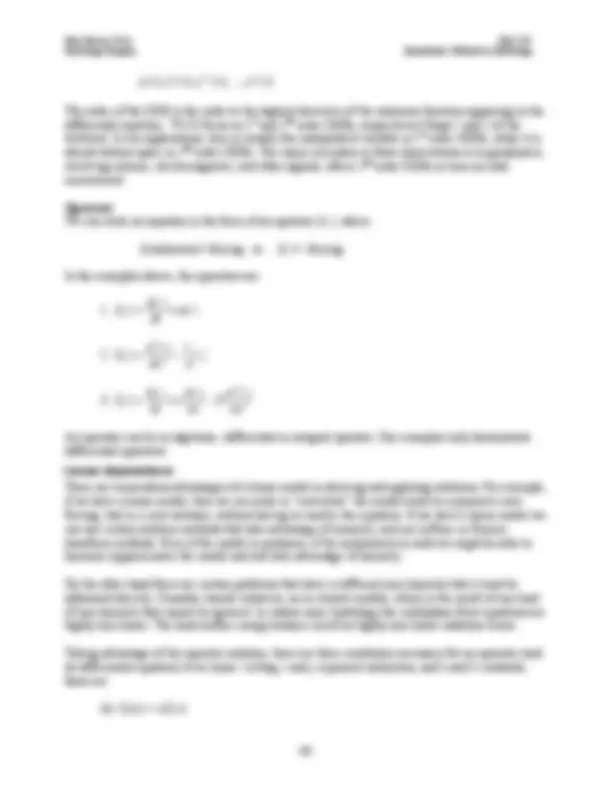
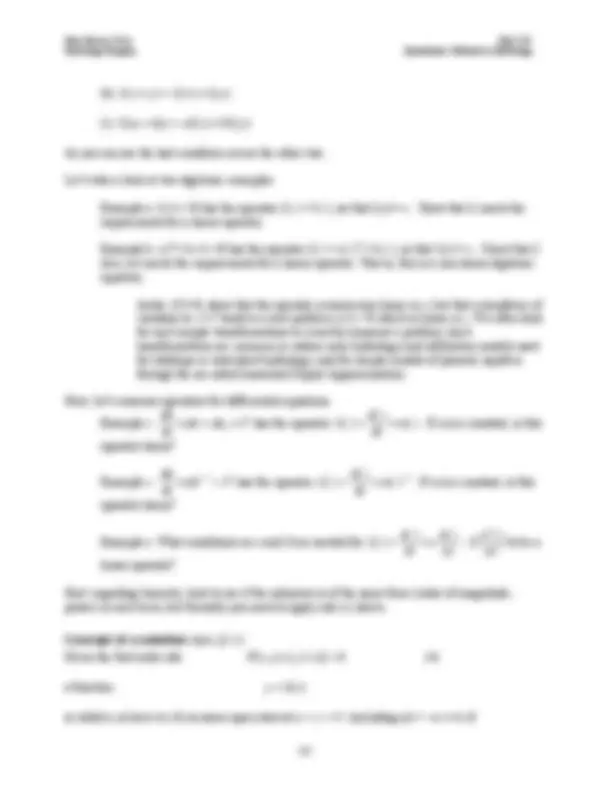
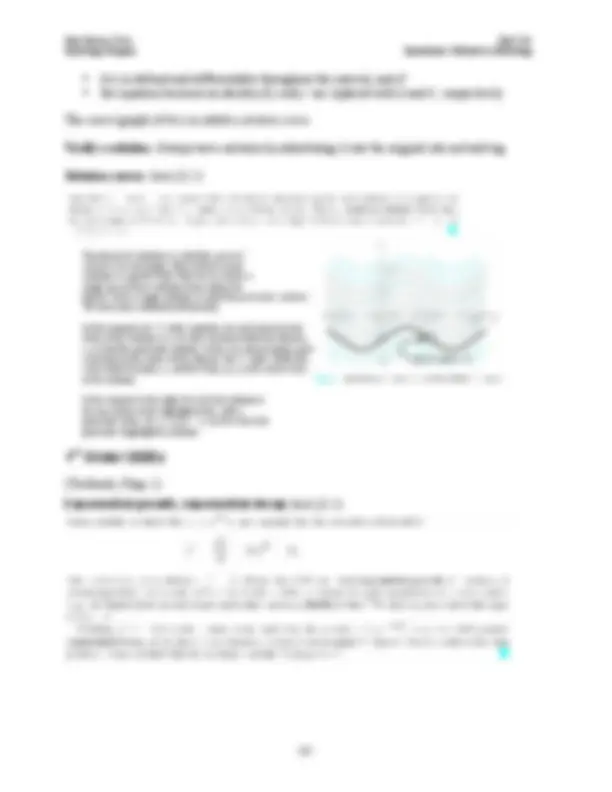
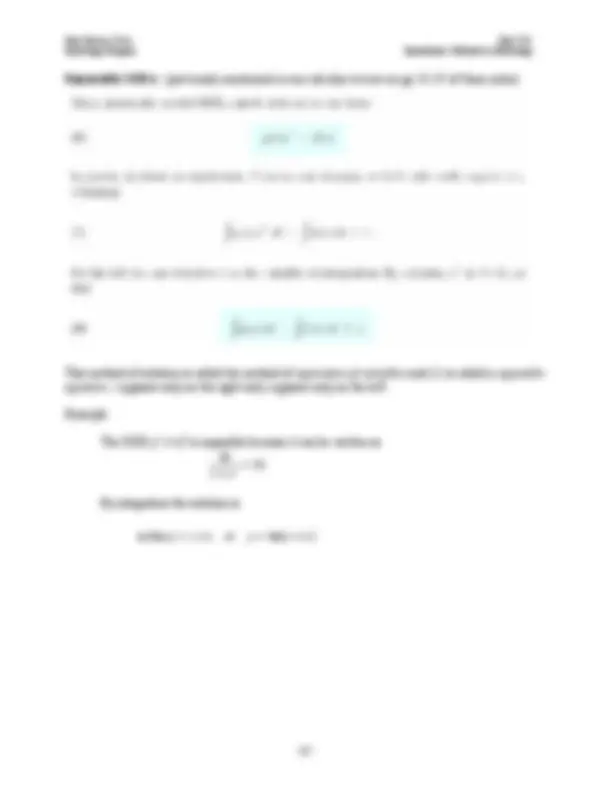

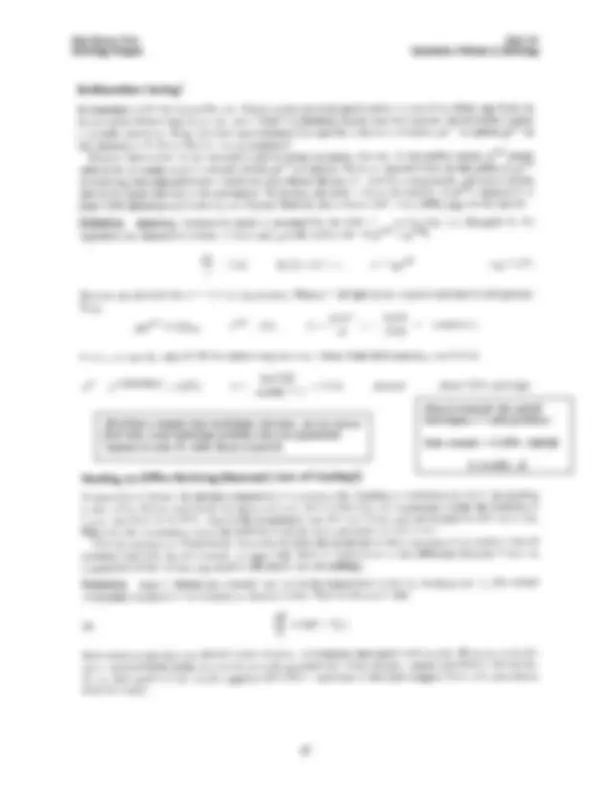
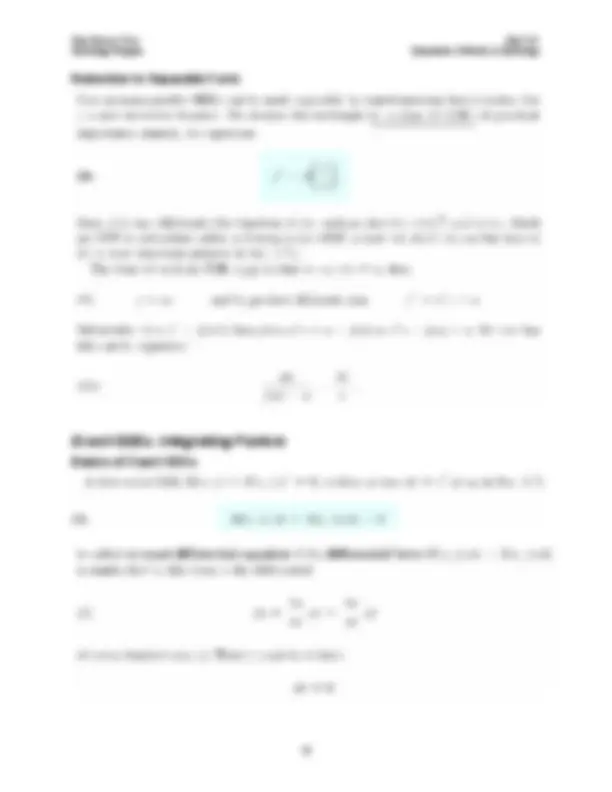
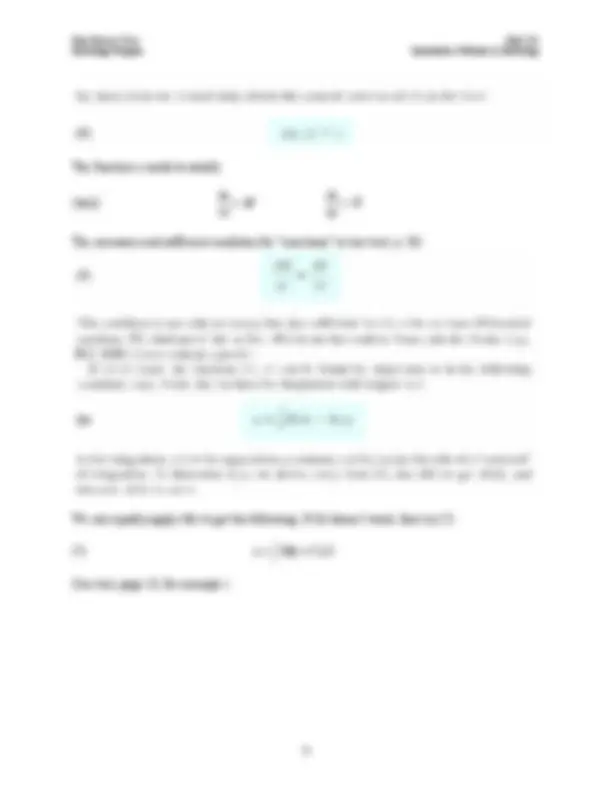



Study with the several resources on Docsity

Earn points by helping other students or get them with a premium plan


Prepare for your exams
Study with the several resources on Docsity

Earn points to download
Earn points by helping other students or get them with a premium plan
Community
Ask the community for help and clear up your study doubts
Discover the best universities in your country according to Docsity users
Free resources
Download our free guides on studying techniques, anxiety management strategies, and thesis advice from Docsity tutors
A part of new mexico tech's hydrology program's quantitative methods in hydrology course material. It focuses on ordinary differential equations (odes) in hydrology, explaining their importance, order, and linearity. It also covers the geometric meaning of odes and methods for solving them, such as the method of separation of variables.
Typology: Study notes
1 / 15

This page cannot be seen from the preview
Don't miss anything!










Hydrology Program Quantitative Methods in Hydrology
(This is new material, see Kreyszig, Chapters 1-6, and related numerics in Chaps. 19, 20, 20.1-20.7, and 21.1-21.3.)
The calculus problems we’ve reviewed have mostly been involved with finding the numerical value of one magnitude or another. For example, we’ve sought the location x 0 and value f ( x 0 ) of the maxima of a function, the locations x where f ( x )=0 (roots of f ( x )), the slope (derivative) of f ( x ) at x ,
b a f ( x ) dx.
But now we are going to solve engineering and science problems where the unknown is itself a function , that is, we are going to develop and solve models that express “the dependence of certain variables on others” (Petrovskii, 1956). What kind of questions can these models answer? Here are some examples from hydrology. How will drawdown in an aquifer change with distance from a pumping well? How will the discharge from a lake, flowing over a weir, vary in time? How does the velocity profile in the atmospheric boundary layer vary with distance above the ground surface? How does moisture content vary with depth? In these cases the dependent (unknown) variables are, respectfully, drawdown [L] 1 , discharge [L^3 ], velocity [L/t], and moisture content [L^3 / L^3 /]=[-]. The respective independent (known) variables are distance [L], time [t], elevation [L], and depth [L].
The problem of finding these functions is most often addressed by solving differential equations , that is, equations in which not only the unknown function(s) occurs, but also its derivatives of various orders.
Examples:
dh
dx
d (^1 1) w ' 2 0
2
∂
x
x
v t
In the first example the unknown is denoted by the letter h , which represents the water level in a lake, and the independent variable by the letter t , which represents time. As there is one independent variable, it is an ordinary differential equation (ODE). As there is only one first order derivative it
(^1) The notation [L] for length and its like (e.g., [M] for mass or [t] for time) is used to indicate units or dimensions of a
variable, similar to using standard units like m (meter), s (second), or kg (kilogram). So velocity units can be indicated by [L/t] or [ms-1]. Among other things we use units to keep track of dimensional homogeneity , such that units balance in all terms on each side of an equation. See next page.
Hydrology Program Quantitative Methods in Hydrology
dependence on the unknown, h. Mathematically, its possible that all three vary with the independent variable, t , but in hydrologic practice only h 0 and P typically vary with time.
In the second example the unknown is denoted by the Greek letter φ , representing hydraulic head in
a confined aquifer, and the independent variable by the letter x , representing location. As there is still just one independent variable, it is also an ordinary differential equation (ODE). However, as a
φ 0 , and Qw ’ denote parameters that are known.
In the third example the unknown is denoted by the letter C , representing solute concentration in a flowing river, and there are two independent variables, denoted by the letters x (space) and t (time). As there are now two (or more) independent variables, it is a partial differential equation (PDE). The highest order derivative in x defines it as a second order equation in space , while the highest order derivative in t defines it as a first order equation in time. (Later we’ll see that this particular type of PDE is called mixed hyperbolic-parabolic PDE.) The symbols v and D denote parameters, the mean river velocity and a “dispersion coefficient.”
In each equation the left side contains the unknown and its derivatives, while the right side contains known loadings or forcings. For example, in the first equation the forcing is precipitation, P [L/t]. In the second equation it is pumping Qw ’ [L/t] and head in a vertically adjacent aquifer, φ 0 [L]. There is no forcing in the third equation (later we’ll see that forcing for that equation comes from the boundary and initial conditions instead). We often rewrite different equations so that they fit this template: unknowns and their derivatives on the left, forcings on the right. As we shall see below, mathematicians take this convention a step further.
In short, the first equation is a first order ODE, the second equation is a second order ODE, and the third equation is a second order in space – first order in time PDE. In this section we concentration only on problems with one independent variable, that is, on ODEs.
Dimensional homogeneity Each of these DEs is (and must be) dimensionally homogeneous. We can take advantage of this to help detect errors and to improve solutions. For example, the second equation is
dx
d (^1 1) w ' 2 0
2 − =− φ − λ
φ λ
φ
influence of aquifer transmissivity ( T [L^2 /t]) and aquitard leakance ( B’/K’ [Lt/L]), where B’ is aquitard thickness [L] and K’ is aquitard vertical conductivity[L/t], and Q (^) w ’ [L/t] is pumping per unit area. All terms in the second equation have units of [1/L].
Order of equation (text, §1.1) An ordinary differential equation of order n , in one unknown function y , is a relation of the form
F [ x , y ( x ), y '( x ), y ''( x ),...., yn ( x )]= 0
Between the (one) independent variable x and the quantitites
(^2) The physical meaning of parameters like these will become known to you later.
Hydrology Program Quantitative Methods in Hydrology
(b) L ( x + y )= L ( x )+ L ( y )
(c) L ( ax + by )= aL ( x )+ bL ( y )
As you can see the last condition covers the other two.
Let’s take a look at two algebraic examples.
Example a: bx+c =0 has the operator L ( ) = b ·( ), so that L(x)=-c. Show that L meets the requirements for a linear operator.
Example b: ax^2 + bx+c =0 has the operator L ( ) = a·( ) 2 + b·( ), so that L(x)=-c. Show that L does not meets the requirements for a linear operator. That is, this is a non-linear algebraic equation.
Aside: if b= 0, show that the operator remains non-linear in x , but that a transform of variables to z=x^2 leads to a new problem az+c =0 which is linear in z. We often look for such simple transformations to (exactly) linearize a problem (such transformations are common in vadose zone hydrology and infiltration models used for hillslope or watershed hydrology, and for simple models of phreatic aquifers through the so-called linearized Dupuit Approximation).
Now, let’s examine operators for differential equations.
Example c: h h P dt
dh
dt
d
operator linear?
Example c: h P dt
dh
dt
d
operator linear?
Example e: What conditions on v and D are needed for (^2)
x
x
v t
= to be a
linear operator?
Hint: regarding linearity, look to see if the unknown is of the same form (order of magnitude; power) in each term; but formally you need to apply rule (c) above.
Concept of a solution (text, §1.1)
Given the first order ode F [ x , y ( x ), y '( x )]= 0 (4)
a function y = h ( x )
is called a solution to (4) on some open interval a < x < b (including a,b = -∞,+ ∞) if
Hydrology Program Quantitative Methods in Hydrology
y
h ( x ) is defined and differentiable throughout the interval, and if the equation becomes an identity if y and y’ are replaced with h and h’ , respectively.
The curve (graph) of h ( x ) is called a solution curve.
Verify a solution. Always test a solution by substituting it into the original ode and solving.
Solution curves. (text, §1.1)
The family of solutions is called the general solution (see next page). Each of these many solutions is equally valid. How do we choose a single one of these solutions from within the family? Such a single solution is called the particular solution. We need some additional information. In this example of a 1st^ order equation, we need just need one value of the solution y ( x 0) at some location within the domain, x 0, to find the particular solution. In fact, we almost always pick a location on the end(s) of the domain. For 1st^ order ODEs this is the initial location, x 0 , and the value y ( x 0) is the initial value of the solution. In the example to the right, the selected solution is the one shown in the highlighted line, with a particular value, y(x0) = y(π) = -2, used to select the particular (highlighted) solution.
1 st Order ODEs
(Textbook, Chap. 1)
Exponential growth, exponential decay (text, §1.1)
y ( x 0) = y ( π ) = -
Hydrology Program Quantitative Methods in Hydrology
Why do this, especially since it is of limited accuracy?
(a) By Matlab, or by a CAS = computer algebra system, like Maple,
Isoclines of y’= f ( x , y ) = xy = k= const., along which the slope is constant.
Hydrology Program Quantitative Methods in Hydrology
Separable ODEs (previously mentioned in our calculus review on pp. 35-37 of these notes)
This method of solution is called the method of separation of variables and (1) is called a separable equation : x appears only on the right and y appears only on the left.
Example:
The ODE y’-1=y^2 is separable because it can be written as
dx y
1 + 2
By integration the solution is
arctan y = x + c or y =tan( x + c )
Hydrology Program Quantitative Methods in Hydrology
67
Keep in mind, for this and all homologous 1 st^ order problems:
Rate constant = 0.693 x half-life
k =0.693 x H
All of these examples have hydrologic relevance. As you can see from them, many hydrologic problems have an exponential response to some IC, either decay or growth.
Hydrology Program Quantitative Methods in Hydrology
68
Most of these problems are forward problems. Given the ODE, IC, and parameter values, how does the unknown vary with the independent variable?
Step 4 is an example of an inverse, or parameter estimation, problem. Given the ODE, IC, and observatioions of the dependent variable, what is an estimate for one or more parameters
Borda’s coefficient of contraction, Cc =0.60, so that A=CcπD^2 /4.
Hydrology Program Quantitative Methods in Hydrology
70
Reduction to Separable Form
Exact ODEs. Integrating Factors
Basics of Exact ODEs
Hydrology Program Quantitative Methods in Hydrology
71
The function u needs to satisfy
(4a,b) M x
∂
y
∂
The necessary and sufficient condition for “exactness” is (see text, p. 20)
We can equally apply (4b) to get the following. If (6) doesn’t work, then try (7).
(See text, page 23, for example.)